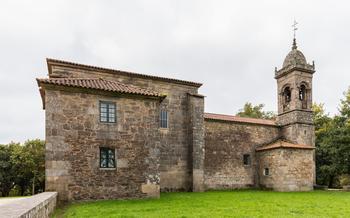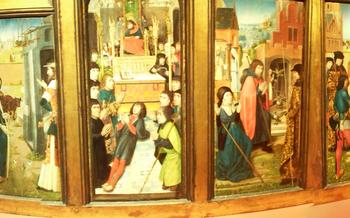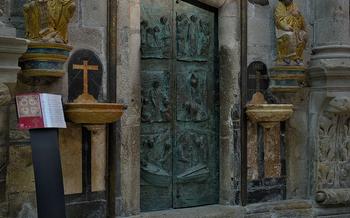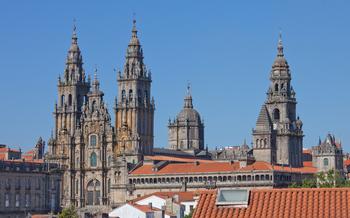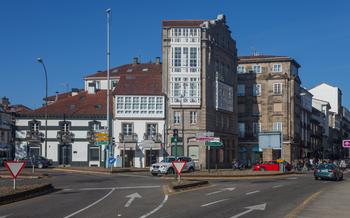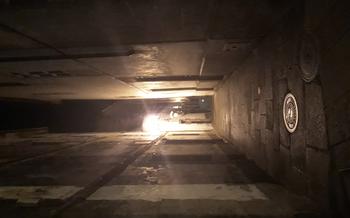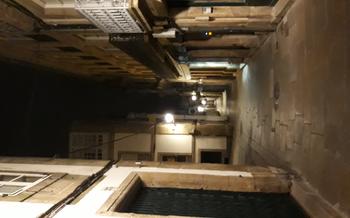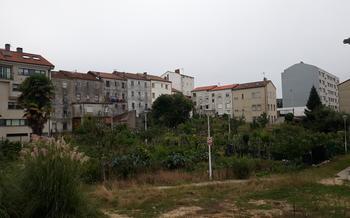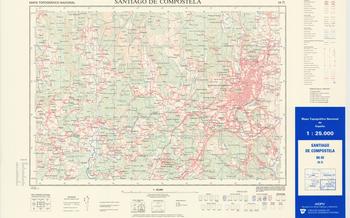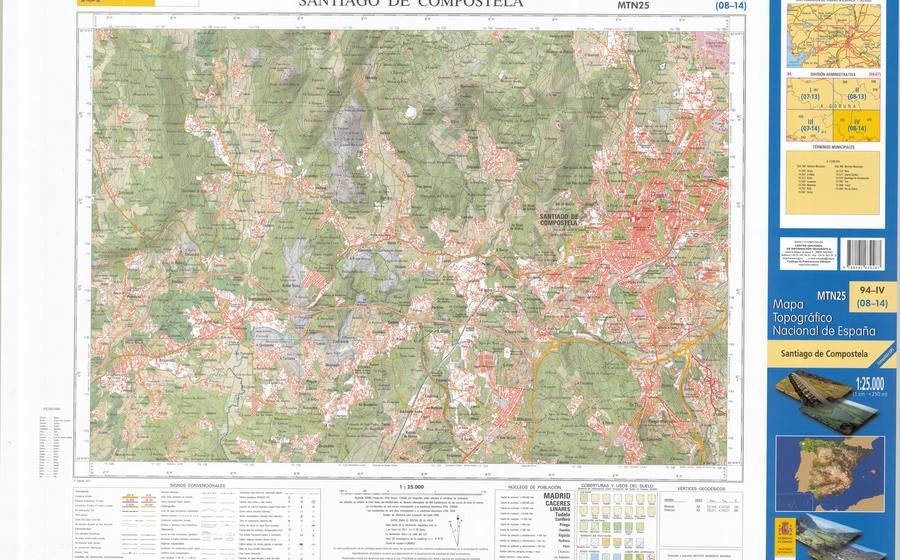
Casa de la Troia Museum set in an 18th century house
- History of the Casa de la Troia Museum
- Location and Getting There
- Architecture and Design
- Historical Importance
- Visitor Information
- Accessibility
- Family-Friendly Features
- Educational Programs
- Research Opportunities
- Events and Activities at the Casa de la Troia Museum
- Gift Shop and Souvenirs
- Accessibility by Public Transportation
- Nearby Attractions
- Insider Tip
History of the Casa de la Troia Museum
Founded in 1952, the Casa de la Troia Museum is a cultural institution aimed at preserving and promoting the rich heritage of the city of Santiago de Compostela. Created by the City Council, it was originally conceived as a museum dedicated to the history and culture of Santiago, with a focus on the city's role as a major pilgrimage destination. The museum is housed in a beautifully preserved 18th-century building, which adds to its historical significance and charm. The Casa de la Troia serves as a valuable resource for scholars and visitors alike, offering insights into the fascinating past of Santiago de Compostela, a city deeply rooted in history and tradition.
Location and Getting There
The Casa de la Troia is located in the heart of Santiago de Compostela, a city in northwestern Spain that is renowned for its religious and cultural significance. The museum resides on Rua do Franco 4, a narrow cobblestone street that is just a short walk from the city's iconic cathedral, the Santiago de Compostela Cathedral. Getting to the museum is relatively easy, whether you choose to navigate the city's charming streets on foot or take advantage of the convenient public transportation options.
For those arriving by car, there is limited street parking available in the surrounding area. However, it is important to note that the city center of Santiago de Compostela is largely pedestrianized, and parking can be challenging. Alternatively, there are several public parking garages located within a short walking distance of the museum, offering a more convenient and secure option for visitors.
If you prefer to use public transportation, the Casa de la Troia is well-connected by bus. The nearest bus stop, "Franco 2," is just a few steps away from the museum, and several bus lines serve this stop, providing easy access from various parts of the city. Additionally, the museum is located within a short walking distance of the Santiago de Compostela train station, making it convenient for visitors arriving by rail.
Architecture and Design
The Casa de la Troia Museum is a stunning example of 18th-century Galician architecture. The building's exterior features a symmetrical facade with intricate carvings and wrought-iron balconies. The interior of the museum is equally impressive, with a grand staircase, vaulted ceilings, and elegant furnishings.
The museum's layout is designed to showcase its diverse collection. The ground floor features a series of galleries dedicated to the history and culture of Santiago de Compostela. The upper floors house exhibits on a variety of topics, including archaeology, ethnography, and fine arts.
One of the most unique architectural elements of the Casa de la Troia Museum is its courtyard. The courtyard is surrounded by a beautiful arcade and features a central fountain. It is a popular spot for visitors to relax and enjoy the tranquility of the museum.
The Casa de la Troia Museum is a must-see for anyone interested in the history and culture of Santiago de Compostela. Its stunning architecture and diverse collection make it one of the most popular attractions in the city.
Historical Importance
The Casa de la Troia's historical significance is deeply intertwined with the history of Santiago de Compostela. It stands as a testament to the city's rich cultural heritage and the influence of the Galician people. The museum's collection offers a glimpse into the everyday lives of the city's inhabitants and the diverse influences that have shaped its development.
The museum's exhibits shed light on Santiago de Compostela's role as a pilgrimage destination, highlighting the significance of the Camino de Santiago and the importance of the city as a spiritual and religious center. Through its collection, the Casa de la Troia helps visitors understand the profound impact that pilgrimage has had on the city's history and culture.
The museum is recognized as a cultural asset of cultural interest in Spain, a testament to its importance as a historical and cultural landmark. Its collection and exhibits have contributed to our understanding of Santiago de Compostela's past, providing valuable insights into the city's evolution and the lives of its people.
Visitor Information
The Casa de la Troia Museum welcomes visitors from all over the world. It is open to the public from Tuesday to Sunday, from 10:00 AM to 2:00 PM and from 4:00 PM to 8:00 PM. The museum is closed on Mondays and public holidays.
Admission to the museum is free of charge for all visitors. However, donations are always welcome and greatly appreciated. The museum relies on donations to continue its work of preserving and showcasing the rich history of Santiago de Compostela.
Guided tours of the museum are available upon request. Tours can be arranged in advance by contacting the museum directly. Guided tours are offered in Spanish, English, and French. There is a small fee for guided tours, but discounts are available for students and groups.
The Casa de la Troia Museum also offers a variety of educational programs and workshops. These programs are designed for visitors of all ages, from children to adults. The museum's educational programs are a great way to learn more about the history and culture of Santiago de Compostela.
Accessibility
The Casa de la Troia Museum is committed to ensuring that all visitors have a welcoming and accessible experience. The museum is wheelchair accessible, with ramps and elevators connecting different levels of the building. Designated areas are provided for wheelchairs or mobility scooters, and accessible restrooms are available on each floor. Visitors with disabilities can also request assistance from museum staff, who are trained to provide support and guidance. The museum's website features detailed accessibility information, including a virtual tour that allows visitors to explore the museum's layout and exhibits remotely. By offering these accommodations, the Casa de la Troia Museum strives to create an inclusive environment where everyone can enjoy and appreciate the museum's collections and exhibits.
Family-Friendly Features
The Casa de la Troia Museum offers a welcoming environment for families with children. Several exhibits and activities are designed to engage young visitors and make learning about history fun and interactive. Families can explore the museum's collection of toys and games, dress up in historical costumes, and participate in hands-on activities that bring the past to life.
The museum also offers family-friendly guided tours that cater to the interests and attention spans of children. These tours highlight the most exciting and kid-friendly exhibits, allowing families to discover the museum's treasures together. Additionally, the museum provides educational materials and resources for parents and teachers to enhance their children's learning experience.
To make the visit even more enjoyable for families, the museum offers discounts for family tickets, allowing parents to save on admission costs. There is also a designated area within the museum where children can play and learn, giving parents a chance to relax and enjoy the exhibits at their own pace.
Educational Programs
The Casa de la Troia Museum offers a variety of educational programs and workshops for visitors of all ages. These programs are designed to deepen understanding and appreciation of the museum's collection and the history of Santiago de Compostela.
School Programs: The museum offers guided tours specifically tailored for school groups, allowing students to explore the exhibits and learn about the city's past in an engaging and interactive way. These tours can be customized to align with specific curriculum requirements.
Workshops and Lectures: The museum regularly hosts workshops, lectures, and seminars on various topics related to its collection and the history of Santiago de Compostela. These events are open to the public and provide opportunities for visitors to delve deeper into specific aspects of the museum's holdings.
Research Opportunities: For researchers and scholars, the Casa de la Troia Museum offers access to its extensive research library and archive. These resources include rare books, manuscripts, and documents related to the history of Santiago de Compostela and the surrounding region. The museum staff is available to assist researchers with their inquiries and provide guidance on research projects.
Educational Resources: The museum's website provides a wealth of educational resources for teachers and students, including downloadable lesson plans, worksheets, and interactive activities. These resources can be used to supplement classroom learning and enhance understanding of the museum's collection and the history of Santiago de Compostela.
Research Opportunities
The Casa de la Troia Museum offers a wealth of opportunities for researchers and scholars interested in Galician history and culture. The museum's extensive collection of artifacts, documents, and photographs provides a rich resource for research in a variety of fields, including archaeology, history, art history, and cultural studies.
The museum's library and archive contain a vast collection of books, manuscripts, and other research materials, including rare and unique items that are not available elsewhere. Researchers can access the library and archive by appointment, and the museum staff is available to assist with research inquiries and provide guidance.
The museum also offers a number of research grants and fellowships to support scholars conducting research related to the museum's collection and history. These grants and fellowships provide financial assistance to researchers to cover travel, research expenses, and other costs associated with their research projects.
In addition, the museum can be rented for educational events and field trips, providing an ideal setting for students and researchers to engage with the museum's collection and learn more about Galician history and culture.
Events and Activities at the Casa de la Troia Museum
The Casa de la Troia Museum offers a variety of special events and activities throughout the year, allowing visitors to engage with the museum's collection and history in new and exciting ways. These events and activities are designed to appeal to a wide range of interests, from history buffs and art enthusiasts to families and children.
One of the most popular events at the museum is the annual "Medieval Market," which takes place every summer. This lively festival transports visitors back in time to the Middle Ages, with vendors selling traditional crafts and food, live music and entertainment, and historical reenactments. The museum also hosts regular lectures, workshops, and concerts, featuring experts in various fields related to the history and culture of Santiago de Compostela. These events provide visitors with an opportunity to learn more about the museum's collection and the city's rich history.
For families with children, the Casa de la Troia Museum offers a variety of educational programs and activities. These programs are designed to engage children with the museum's collection and history in a fun and interactive way. Children can participate in hands-on activities, such as making their own medieval crafts or learning about the history of the city through interactive games. The museum also offers guided tours specifically designed for children, which provide a fun and educational experience for the whole family.
Whether you are interested in history, art, or simply looking for a fun and educational experience, the Casa de la Troia Museum offers a variety of events and activities that are sure to appeal to visitors of all ages. Be sure to check the museum's website or social media pages for up-to-date information on upcoming events and activities.
Gift Shop and Souvenirs
The Casa de la Troia Museum features a well-stocked gift shop where visitors can purchase a variety of souvenirs and mementos to commemorate their visit. The shop offers a diverse selection of items, including postcards, books, and reproductions of artifacts from the museum's collection. Visitors can also find unique and exclusive souvenirs, such as replicas of ancient coins, jewelry inspired by historical designs, and hand-crafted ceramics. The gift shop provides an excellent opportunity to take home a piece of Santiago de Compostela's rich history and culture.
Accessibility by Public Transportation
The Casa de la Troia Museum is conveniently located in the historic center of Santiago de Compostela, making it easily accessible by public transportation. Visitors can take advantage of the city's extensive bus network to reach the museum. Several bus lines, including lines 1, 11, and 17, stop within a short walking distance of the museum.
For those arriving by metro, the closest station is the "O Toural" station on Line From there, it is a leisurely five-minute stroll to the museum. Additionally, there is a park-and-ride facility located on the outskirts of the city, allowing visitors to park their cars and take a bus or metro into the city center.
Nearby Attractions
The Casa de la Troia Museum is located in the heart of Santiago de Compostela, a city steeped in history and culture. Visitors can easily explore other attractions within walking distance of the museum. The iconic Santiago de Compostela Cathedral, a UNESCO World Heritage Site, is just a short stroll away. The cathedral is renowned for its stunning architecture, intricate carvings, and the legendary tomb of Saint James the Great.
Other nearby attractions include the Plaza del Obradoiro, a lively square surrounded by historic buildings, and the Mercado de Abastos, a bustling market offering fresh local produce, seafood, and traditional Galician delicacies. The Alameda Park, with its serene gardens and fountains, provides a tranquil oasis in the city center. Visitors can also explore the narrow cobbled streets of the old town, lined with charming shops, cafes, and restaurants.
Insider Tip
- To fully immerse yourself in the local culture, visit the museum during the annual Festa do Apóstolo Santiago, held in July. The city comes alive with parades, music, and traditional Galician festivities, making it a vibrant time to experience Santiago de Compostela.
- Take advantage of the museum's free admission on Sundays. This is a great opportunity to explore the Casa de la Troia's collection without any financial constraints.
- If you're interested in learning more about the history of Santiago de Compostela, consider booking a guided tour of the city. These tours often include a visit to the Casa de la Troia, providing valuable insights into the museum's significance and the city's rich past.
